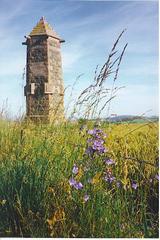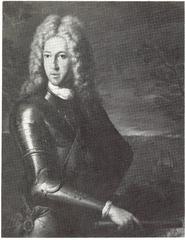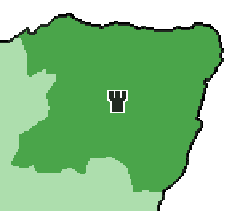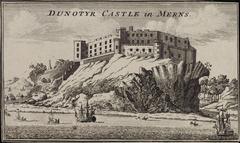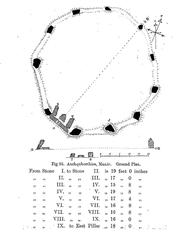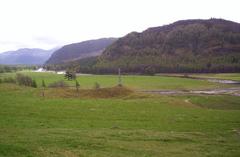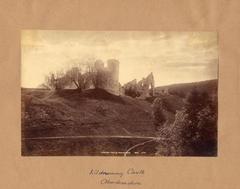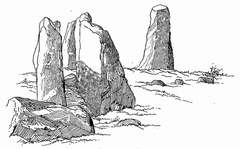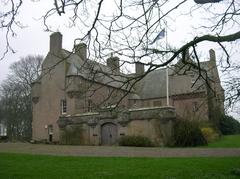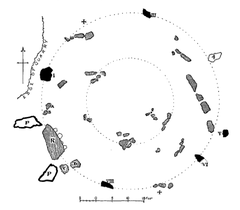
Complete Guide to Visiting Corgarff Castle, Ballater, United Kingdom
Date: 04/07/2025
Introduction
Corgarff Castle, perched amid the sweeping moorlands of Strathdon near Ballater in Aberdeenshire, is a striking emblem of Scotland’s storied past. Famous for its dramatic clan feuds, pivotal military role during the Jacobite risings, and unique star-shaped defensive walls, the castle offers visitors an immersive journey into Highland history and architecture. This guide consolidates all essential information—covering historical background, visiting hours, ticketing, accessibility, travel tips, and notable nearby attractions—so you can make the most of your visit to this remarkable Aberdeenshire site (Great Castles; Historic Environment Scotland).
Table of Contents
- Introduction
- Historical Overview
- Architectural Features
- Visiting Information
- Nearby Attractions
- Frequently Asked Questions (FAQ)
- Conclusion
- References
Historical Overview
Early Origins and Clan Feuds
Corgarff Castle’s story begins in the early 16th century, when King James IV granted the lands to the Elphinstone family. Around 1530, a classic Scottish tower house was built, soon leased to the Forbes of Towie (Great Castles; Wikipedia). The castle’s early years were marred by a violent feud between the Forbes and Gordon clans, culminating in 1571 when Adam Gordon of Auchindoun attacked. Margaret Campbell, Lady Forbes, and 26 others perished in a fire set by Gordon’s men—a harrowing event immortalized in the ballad “Edom o Gordon” (Jacobite Trail).
Throughout the 17th century, the castle changed hands multiple times, reflecting the turbulent political landscape. It was used as a stronghold during civil wars and was repeatedly damaged and rebuilt (Rampant Scotland; Historic Environment Scotland).
Jacobite Uprisings and Military Barracks
Corgarff’s isolated location made it a strategic site during the Jacobite uprisings of the 18th century. It was used to store weapons and muster rebels, and was burned several times to deny its use to opposing forces (Stravaiging). After the final defeat of the Jacobites at Culloden, the British government transformed the castle in 1748 into a military barracks and outpost. Its interior was remodeled to house officers and up to 42 soldiers, while the original courtyard was replaced with a distinctive eight-pointed star-shaped curtain wall with musket loops (Secret Scotland). This fortification is a rare example in Scotland, reflecting advances in defensive military architecture (Britain Express).
Suppression of Whisky Smuggling
Corgarff Castle’s military use persisted into the 19th century. In the 1820s, it became a base for excise officers combating illegal whisky distillation and smuggling in the surrounding Highlands. The garrisoned troops patrolled the area, disrupting illicit activities until the army withdrew in 1831 (VisitScotland; Secret Scotland).
Restoration and Modern Stewardship
After its military use ended, Corgarff Castle was used as a farmhouse and later fell into disrepair. In the mid-20th century, the castle was placed into state care, and Historic Environment Scotland restored it to its 18th-century barracks appearance (Stravaiging). Today, the castle stands as a testament to the region’s layered history and is open to the public seasonally.
Architectural Features
Corgarff Castle’s most iconic feature is its star-shaped curtain wall, constructed in the 18th century to provide overlapping fields of fire—a rarity in Scottish defensive design. The original four-storey tower house retains period features such as a machicolation above the entrance, spiral staircases, and vaulted ground floors. Inside, reconstructed barracks, a small whisky still, and interpretive displays tell the story of soldiers, excise officers, and clansfolk who once occupied these walls (The Mind Circle; Great Castles).
Visiting Information
Opening Hours and Tickets
- Seasonal Opening: April 1 to September 26
- Hours: 9:30 AM–5:30 PM (last entry 4:00 PM); castle closed for lunch 12:30 PM–1:30 PM
- Tickets (2023):
- Adults: £7.50
- Children: £4.50
- Concessions: £6.00
- Family tickets: £15.00–£21.50
- Historic Scotland Members: Free entry (Historic Environment Scotland; My Voyage Scotland; 24Countries).
Advance booking is recommended for groups or during peak periods. Always confirm current hours and ticket prices before your visit (Evendo).
Getting There and Parking
- By Car: Located just off the A939, about 15 miles north of Ballater and 8 miles west of Strathdon. Free parking is available adjacent to the castle (My Voyage Scotland).
- By Public Transport: Limited services. The nearest bus runs from Aboyne to Strathdon, with a 2-mile walk along the A939 to the castle (Evendo).
Facilities and Accessibility
- Toilets: Basic facilities onsite; no baby changing.
- Food/Drink: No café or shop—bring your own refreshments. Nearest options in Strathdon or Ballater.
- Accessibility: Historic, uneven terrain and narrow staircases; limited wheelchair access. Contact Historic Environment Scotland in advance for specific needs (Experienced Tours).
- Parking: Free for cars and small coaches.
Guided Tours and Interpretation
- Live Guided Tours: Not regularly scheduled, but seasonal tours may be available—check ahead.
- Interpretive Displays: Detailed panels and reconstructed rooms illustrate the castle’s history, military life, and role in whisky smuggling. Audio guides or printed materials may be available (Scotland’s Castle Country).
Practical Visitor Tips
- Weather: The Cairngorms are unpredictable—dress in layers, with waterproofs and sturdy shoes (Wanderlog).
- Photography: The star-shaped wall and Highland backdrop are excellent for photos, especially at sunrise or sunset. Drone use requires permission.
- Mobile Coverage: Limited—carry a map or GPS, and fuel up before your visit.
- Winter Visits: The A939 may be closed due to snow or ice; check road conditions in advance.
What to See and Do
- Star-Shaped Curtain Wall: Walk the perimeter for panoramic views and to appreciate its defensive design.
- Barracks Rooms: Explore reconstructed interiors depicting 18th-century military life.
- Whisky Smuggling Exhibit: See a small whisky still and learn about the castle’s law enforcement role.
- Wildlife and Scenery: Spot local fauna and enjoy the dramatic moorland setting.
- Legends and Ghost Stories: Discover tales of clan conflict and reported hauntings (24Countries; Experienced Tours).
Nearby Attractions
Corgarff Castle is a gateway to several other Aberdeenshire historical and scenic sites:
- Balmoral Castle
- Braemar Castle
- Crathes Castle
- Glenbuchat Castle
- Kildrummy Castle
- Tomnaverie Stone Circle
Outdoor enthusiasts can also enjoy hiking and winter sports at Lecht and explore Ballater village with its local shops and eateries (Visit Ballater).
Frequently Asked Questions (FAQ)
Q: What are the opening hours of Corgarff Castle?
A: Typically April to September, 9:30 AM–5:30 PM (last entry 4:00 PM), with a lunch closure. Always check official sources before your visit.
Q: How much are tickets?
A: Adults £7.50, children £4.50, concessions £6.00, family tickets £15.00–£21.50. Free for Historic Scotland members.
Q: Is the castle accessible for wheelchairs?
A: Accessibility is limited due to uneven terrain and historic staircases. Contact Historic Environment Scotland for details.
Q: Are guided tours offered?
A: Seasonal tours may be available; otherwise, enjoy interpretive displays and reconstructed rooms.
Q: Can I fly a drone at the castle?
A: Permission from Historic Environment Scotland is required.
Q: Are there refreshments or a shop on site?
A: No—bring your own food and drink.
Conclusion
Corgarff Castle stands as a compelling destination for history enthusiasts, photographers, and anyone eager to explore Aberdeenshire’s rich heritage. Its unique star-shaped defenses, turbulent clan history, and breathtaking Highland scenery create an unforgettable visitor experience. Plan ahead by checking current visiting hours, ticketing, and weather conditions, and consider combining your visit with other nearby historical sites. For the latest updates, virtual resources, and travel tools, consult official channels and download the Audiala app.



